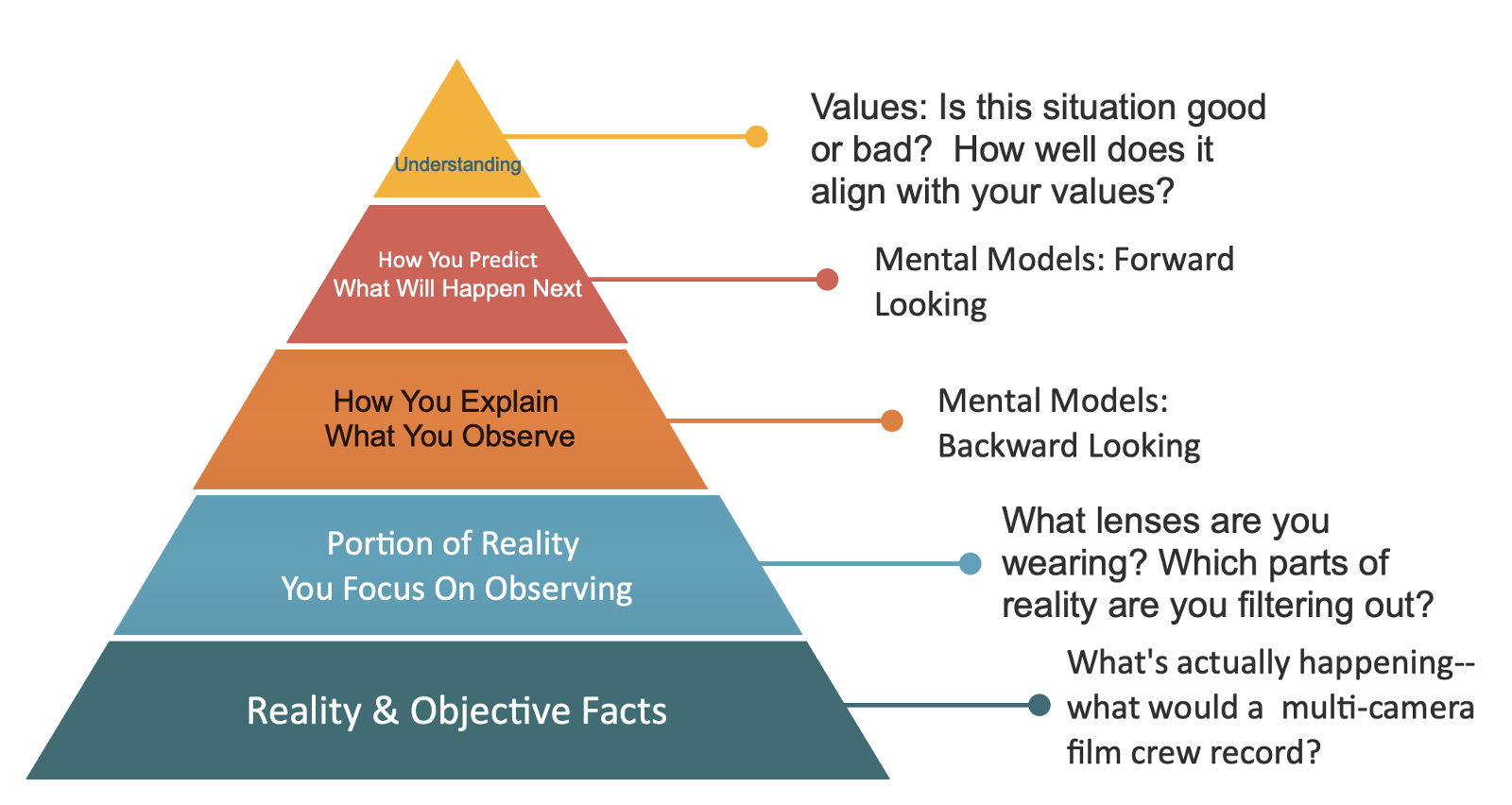5 Tools for High Stakes Communications: Tool #4, The Ladder of Understanding
Jun 15, 2022Tool #4: Ladder of Understanding
This is a tool to use when you can’t understand how someone else could see something so differently. What could they possibly be thinking!? Perhaps not surprisingly, the way to get insight about someone else’s conclusions is to start by more closely examining your own!
Originally developed as the “Ladder of Inference” by Chris Argyris, and also labeled the “Ladder of Reflection” by Diana McLain Smith in her book Elephant in the Room, I prefer to call this tool the “Ladder of Understanding.” Whatever name you choose, it provides a framework for making clear the chain of reasoning that leads us from objective, observable facts all the way to value judgments about what is good and bad, right and wrong. The key insight here is that our brains work very quickly, and it’s common to jump immediately from our observation of a situation all the way to a value judgment without even being conscious of our thought process in between.

As human beings, we are prone to all kinds of cognitive biases. The kicker is that we can’t see these blindspots, and so we trust our own thought process more than we should. This tendency can add fuel to the fire in our most high stakes interactions with others. We often have a high degree of confidence that our understanding of the situation is spot on, and so we also believe that any right thinking person would understand things the same way. This means we are quick to attribute bad motives if someone claims to see things differently.
What’s the antidote? Slow down enough to walk yourself backwards through all the steps (and assumptions) you took to reach your final conclusion based on your initial observations. Then co-create a new ladder of understanding with the other person, one step at a time.

Let’s dig a bit deeper to see how this works. The ground the ladder is resting on is reality and objective facts. The first step up the ladder is the portion of reality you actually observe. A lot of times we don’t record reality objectively; we focus on only a portion of what actually happened, and so our understanding of objective reality is already narrowed.
The next step up the ladder is how you explain what you observed to yourself. We all rely on mental models to explain why things happened in the way we observed. The step beyond that is that we very often want to predict what will happen next. Here, again, we draw on pre-existing mental models. We are typically deeply attached to our mental models, and often not even aware we are using them. For example, many of us have a deeply entrenched mental model that we can predict the behavior of our whole economy based on the idea that individual people reliably act to advance their own self interests regardless of what is best for others. This is the fundamental model for classic economics and Adam Smith’s “invisible hand.” Often, we carry around these mental constructs unconsciously, and we cling to them even when contrary evidence emerges, such as survey research suggesting 50% or more of the population have a “pro-social” orientation and are willing to sacrifice gains for themselves for the sake of others getting what they need.
The final rung of the ladder is our conclusion, where we form an overall understanding of the situation and we make a judgment about whether it is aligned with our values. Is it good, bad, or indifferent?
3 Steps for Using The Ladder of Understanding
Here’s how to put this tool to use in practical terms when you reach a sticking point in a high stakes conversation:
Step 1: Figure out which rung you are on. Are you still fairly low down on the ladder, say at the stage of observing what’s going on around you? Or are you at the top of your ladder? Have you already formed a harsh judgment of someone else because you think you fully understand the situation and you believe that their actions are not in accord with your values?
Step 2: Evaluate your reasoning by walking back down the ladder, step by step, until you get all the way back to objective reality. Look for any unwarranted or inaccurate assumptions that you might have made in your original reasoning process.
Step 3: Rebuild the ladder in a conversation with your counterparty, explicitly communicating about each step as you go. Narrate your assumptions as you move up the ladder, all the way to a shared understanding that is consistent with values that you both share.
Practice Makes Progress
It might seem hard to imagine using this tool in practice, especially if you are really at odds with someone else and the conversation has gotten heated. As you develop greater facility with these tools, you may find that combining them is really effective. For example, you can use Step Five of an I-message to suggest using the Ladder of Understanding as a mutually beneficial step forward: “Could it work for both of us if we took a pause and shared our thinking about how we each reached our point of view? Maybe we can peel the onion here and see if we might each have missed something along the way.”
Stay connected with news and articles
Join us to receive the latest news and updates from our team.
Don't worry, your information will not be shared, and you can unsubscribe at any time
We hate SPAM. We will never sell your information, for any reason.

